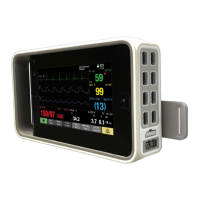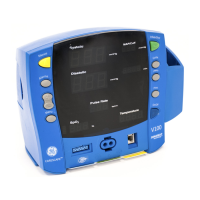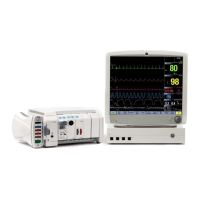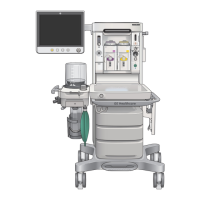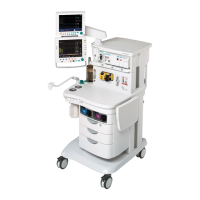Pulseoximetry
WARNING
Manyfactorsmaycauseinaccuratereadingsandalarms,
decreasedperfusion,andorlowsignalstrength:
●Interferingsubstances:
■CarboxyhemoglobinmayerroneouslyincreaseSpO
2
reading.
■Methemoglobin(MetHb)usuallyrepresentslessthan1%
ofthetotalHb,butinthecaseofmethemoglobinemia
thatcanbecongenitalorinducedbysomeIVdyes,
antibiotics(suchassulphas,)inhaledgasesetc.this
levelincreasessharplyandthuscancauseinaccuracies
intheSpO
2
reading.
■Intravasculardyes(suchasindocyaninegreen,
methyleneblue,etc.)
●Physiologicalcharacteristics:
■Cardiacarrest
■Hypotension
■Shock
■Severevasoconstriction
■Severeanemia
■Hypothermia
■Venouspulsations
■Darklypigmentedskin
■Ventricularseptaldefects(VSDs)
●Environmentalconditions:
■Excessiveambientlight
■Electricalinterference
■Electrosurgery
■Debrillation-Maycauseinaccuratereadingforashort
amountoftime.
■Excessivepatient/sensormotion.Artifactcansimulate
anSpO
2
reading,sothatthemonitorfailstosoundan
alarm.Inordertoensurereliablepatientmonitoring,the
properapplicationoftheprobeandthesignalquality
mustbecheckedatregularintervals.
●Sensorplacement:
■Incorrectsensorplacement-prolongedmonitoringor
incorrectsensorapplicationcancauseskinirritationor
impairedcirculation.Itisrecommendedthatyoucheck
theprobesiteeveryfourhours(morefrequentlyforpoor
perfusionorforneonates).Refertotheinstructions
suppliedwiththesensor.
■Sensorplacementonthesameextremityasablood
pressurecuff,arterialcatheterorintravascularline;or
arterialocclusionproximaltothesensor.
■Poorsensort.
■Donotallowtapetoblockthesensorlightemitterand
detector.
2062971-001CARESCAPEModularMonitors203
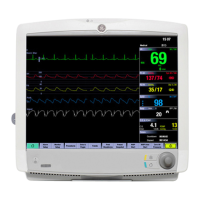
